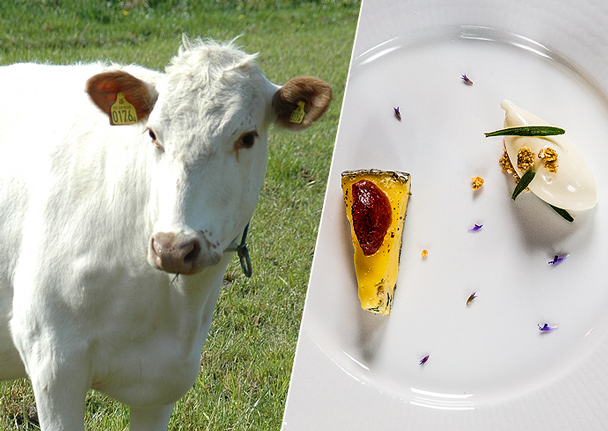Pärla may well be the most famous cow in all of Sweden. Seven years old, she is as white as the pearl she is named after, although her breed—the indigenous Fjäll, or Swedish Mountain cattle—often comes flecked with Pollack-esque black blotches. She is a timid creature, hesitant to meet your gaze from behind her long lashes, reluctant to explore far from home. But she does one thing exceedingly well: produce delicious milk. So delicious, in fact, that one restaurant serves cheese made only from hers.
Call it single-cow cheese. In an age in which a growing number of people want to know where their food comes from, one man has taken the idea of local sourcing to a new extreme. At PM & Vänner, a highly regarded restaurant in Sweden's southern city of Växjö, co-owner Per Bengtsson came up with the idea of creating a cheese whose origins could be precisely determined. Very precisely.
One of the things that makes farm-to-table cuisine so compelling, for those who create and consume it, is the undeniable appeal of story. Knowing where the food on the plate comes from—who produced it, how, and where—adds an intimacy to the act of eating. That's something that Bengtsson understood intuitively as he set about a way to remind his diners that even a processed food, like cheese, comes from someplace and something.
Cheese is normally made from a blend of numerous animals' milk. Industrially produced cheese combines the milk from hundreds, if not thousands, of animals, but even on small farms, where cheese makers use milk only from their own herds, blending ensures consistency and quality. That way, fat content and flavor, for example, can be maintained regardless of fluctuations within any given animal's output. And without blending, a cheese maker would face economic ruin every time an individual animal's milk production dropped—which is why Bengtsson initially encountered resistance to his concept.
In 2007, he pitched the idea to Annelie Söder, who, with her daughter Anna, runs a small dairy farm called Agnes on Kläcklingen Island in Lake Åsnen, not far from Bengtsson's restaurant. "They thought it was very strange," Bengtsson confides. "On the one hand, they loved the idea. But on the other, they thought I was crazy."
Yet to Bengtsson, it all made perfect sense. Ever since opening PM & Vänner in 1992, his restaurant has had a mantra of sorts: "forest, lake, meadow." These are the distinguishing features of the landscape in Småland, where Växjö lies, and thus the inspiration for PM & Vänner's menu, which combines local ingredients with modern techniques (chef de cuisine Simon Lennblad trained at Ferran Adrià's El Bulli). "I'm always looking for new products, both wild and farmed," Bengtsson says, "because we focus on terroir. And then I had the ultimate terroir thought."
That's when he turned to Söder and her daughter Anna, whose Agnes Dairy was known for its rich, creamy blue cheese. He also liked the fact that the farm raises Fjäll cows, not only because they're native to the area but because the breed gets bonus points for sustainability: Fjälls require less feed than others, which means they can survive in poorer soils. But at Agnes, Söder's 18 cows have a smorgasbord on which to graze: a variety of grasses, wild herbs, and 15 different types of trees populate the farm's meadows.
Once Bengtsson overcame Söder's skepticism about the single-cow project, the two set about narrowing the field of candidates, tasting their way through each cow's milk. In the end, the choice was clear. "Because it had higher fat and protein content, you could clearly taste all those things [she had been grazing on] in Pärla's milk," says Bengtsson. "The taste was outstanding."
Once they had their cow, Bengtsson began working with Söder to create the cheese. Pärla gives around 4 gallons of milk a day, and it takes much of that to produce a single mold (1.5 kilos, or 3.3 pounds) of cheese, so it usually takes three or four days before enough milk is on hand to warrant starting the process. Bengtsson and Söder have settled on three types of cheese, all of which are available exclusively at PM & Vänner: a fresh cottage-type cheese, a blue, and a hard cheese. At the restaurant, the cheese is served both plain and in a number of innovative dishes: One creation is a fresh "snow" that pairs well with elk tartare; another combines the blue cheese with chocolate and a locally foraged sea buckthorn marmalade. Pärla's raw milk also is used in several dishes because, Bengtsson finds, its rich, intensely buttery flavor adds a "magical" element.



 Pinterest
Pinterest


